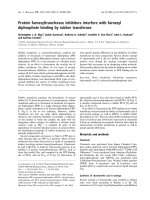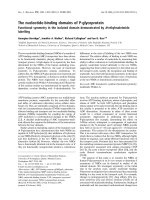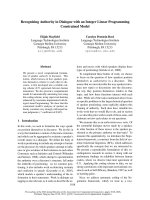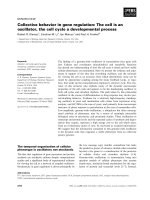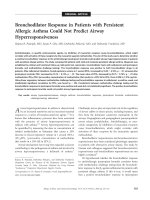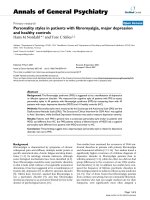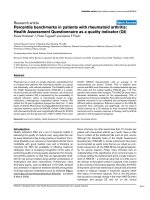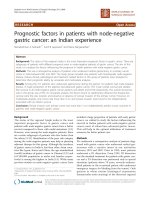báo cáo khoa học: "Prognostic factors in patients with node-negative gastric cancer: an Indian experience" pdf
Bạn đang xem bản rút gọn của tài liệu. Xem và tải ngay bản đầy đủ của tài liệu tại đây (243.12 KB, 6 trang )
RESEARCH Open Access
Prognostic factors in patients with node-negative
gastric cancer: an Indian experience
Ramakrishnan A Seshadri
1*
, Sunil B Jayanand
1
and Rama Ranganathan
2
Abstract
Background: The status of the regional nodes is the most important prognostic factor in gastric cancer. There are
subgroups of patients with different prognosis even in node-negative patients of gastric cancer. The aim of this
study is to analyze the factors influencing the prognosis in Indian patients with node-negative gastric cancer.
Methods: This was a retrospective analysis of patients who underwent radical gastrectomy in a tertiary cancer
centre in India between1991 and 2007. The study group included only patients with histologically node-negative
disease. Various clinical, pathological and treatment related factors in this group of patients were analyzed to
determine their prognostic ability by univariate and multivariate analyses.
Results: Among the 417 patients who underwent gastrectomy during this period, 122 patients had node-negative
disease. A major proportion of the patients had advanced gastric cancer. The 5-year overall survival and disease-
free survival in all node-negative gastric cancer patients was 68.2% and 67.5% respectively. The overall recurrence
rate in this group was 27.3%. On univariate analysis, the factors found to significantly influence the disease-free
survival were the size, location and presence or absence of serosal invasion of the primary tumor. However, on
multivariate analysis, only tumor size more than 3 cm and serosal invasion were found to be independently
associated with an inferior survival.
Conclusion: Serosal invasion and primary tumor size more than 3 cm independently predict a poor outcome in
patients with node-negative gastric cancer.
Background
The status of the regional lymph nodes is the most
important prognostic factor in gastric cancer and
patients with node -negative gastric cancer have a bett er
survival compared to those with nodal metastasis [1,2].
However, even among the node-negative pat ients, there
are certain subgroups of patients who fare better than
the others [3-13]. Identification of the poor risk category
among the node-negative patients may help in planning
adjuvant therapy for this group. Although the incidence
of gastric cancer in Indi a is less than other Asian coun-
tries like Japan, Korea and China, the age-standardized
(world) incidence of gastric cancer in Chennai (12.2 and
6.0/100,000 population in males and females respec-
tively) is among the highest in India [14]. While many
previous studies on node-negative gastric cancer have
included a large proportion of patients with early gastric
cancer, we wished to study the factors influencing the
survival in Indian patients with node-negative gastric
cancer, most of whom have advanced gastric cancer.
This will help in the o ptimal utilization of treatment
resources for better patient care.
Methods
We undertook a retrospective analysis of patients diag-
nosed with gastric cancer who underwe nt radical gas-
trectomy with a curative intent in o ur institution
between 1991 and 2007. Prior to 1993, most patients
underwent a D1 dissection. From 1993, D2 dissection
was the standard treatment for patients with gastric can-
cer and a D1 dissection was performed only in special
situations (patients above 70 years, severely malnour-
ished patients or the occasional patient who underwent
emergency surgery for bleeding from the tumor). Only
patients in whom routine histological examination
(hematoxylin-eosin staining) of the dissected regional
* Correspondence:
1
Department of Surgical Oncology, Cancer Institute (WIA), Chennai-600036,
India
Full list of author information is available at the end of the article
Seshadri et al. World Journal of Surgical Oncology 2011, 9:48
/>WORLD JOURNAL OF
SURGICAL ONCOLOGY
© 2011 Seshadri e t al; licensee BioMed Centra l Ltd. This is an Open Access article distribut ed under the terms of the Creative Commons
Attribution License ( which permits unrestricted us e, distribution, and reproduction in
any medium, provided the original work is properly cited.
lymph nodes did not reveal evidence of nodal metastasis
were included in the study group. The UICC TNM 6
th
edition staging system was used for staging the disease
[15]. Patients i n whom all examined lymph nodes were
negative for metastasis regardless of the number of
nodes dissected were still designated as pN0 according
to the UICC TNM guidelines [15] and were included in
the analysis. Patients with carcinoma-in-situ were
excluded from the study, since the risk of nodal metas-
tasis is very low in these patients and they cannot be
compared with invasive malignancies.
Adjuvant chemotherapy was not administered to any
of the patients. The tumors were divided into proximal
or distal by an imaginary line between the incisura and
the mid-point of the greater curve. The patients were
followed 3-monthly for the first three years, 6-monthly
for the next two years and then annually thereafter.
Clinical examination was performed at each visit and
abdominal imaging studies (computerized tomography
scan or an ultrasound) was requested every year for the
first five years. An endoscopy was performed once a
year for three years. Local recurrence identified on
endoscopy was always confirmed by a biopsy. Nodal or
distant recurrences were identified on imaging and a
biopsy was not attempted unless the imaging result was
equivocal. The median duration of follow-up of all
patients in this study (including 5 patients who had a
30-day mortality) was 58 months (range 1 to 202
months). Univariate analysis of various prognostic fac-
tors influencing the disease-free survival (DFS) was per-
formed using log-rank test. Factors identified to be
significant in univariate analysis were included in the
multivariate analysis, which was performed using the
Cox proportional hazard model. The survival estimates
were calculated by life-table method. Statistical signifi-
cance was considered when p value was < 0.05. The
SPSS v11.0.1 software was used for statistical analysis
Results
Among the 417 patients who underwent radical gas-
trectomy during the study period, 122 patients had his-
tologically node-negative disease. After excluding one
patient with carcinoma-in-situ, the study population had
121 patients (29%). Table 1 enlists the patient, surgical
and pathological details of the node-negative patients.
More than 80% of the patients had advanced gastric
cancer (predominantly T3 disease) and D2 lymphade-
nectomy was performed in 81% of the patients.
On follow-up, recurrence was detected in 33 patients
(27.3%). Of this, distant metastasis was seen in 24
patients (19.8%), isolated locoregional recurrence in 6
patients (4.9%) and combined locoregional and distant
recurrence was seen in 3 patients (2.4%). The 3-year
and 5-year overall survival in node-negative patients
were 76% and 68.2% respectively, whereas the 3-year
and 5-year disease-free survival were 73.6% and 67.5%
respectively. In contrast, the 5-year overall survival of
the 295 patients who had node-positive disease was
29.1%, which was significantly lower than that of node-
negative patients (p < 0.001).
On univariate analysis, the only factors which were
found to be significantly associated with a poor disease-
free survival in patients with node-negative gastric can-
cer were tumor size >3 cm, proximal tumor location
and the presence of serosal invasion in the primary
tumor (Table 2). The age of the patient, gender, histol-
ogy and grade of the tumor did not correlate signifi-
cantly with survival. There was a non-significant trend
towards better survival in patients in whom >15 nodes
were dissected when compared to those with fewer
number of dissected nodes. Similarly, although there
Table 1 Clinical, pathological and treatment details of
node negative patients
Variable No. (%)
Gender
Male 86
Female 35
Median age (range) 53 years (27-76)
Depth of invasion
pT1 22 (18.2)
pT2 33 (27.3)
pT3 64 (52.9)
pT4 2 (1.7)
Size of primary tumor
≤3 cm 18 (14.9)
>3 cm 85 (70.2)
Grade
1 12 (9.9)
2 39 (32)
3 70 (57.9)
Histology
Adenocarcinoma 102 (84.3)
Mucin secreting carcinoma 13 (10.7)
Signet-ring cell carcinoma 6 (5)
Type of gastrectomy
Distal 97 (80.2)
Total 21 (17.4)
Proximal 3 (2.5)
Extent of lymphadenectomy
D1 23 (19)
D2 98 (81)
Median no. of dissected nodes (range) 22 (4-77)
No. of nodes dissected
≤15 39 (32.2)
>15 82 (67.8)
Seshadri et al. World Journal of Surgical Oncology 2011, 9:48
/>Page 2 of 6
was a trend towards improved survival in patients
undergoing D2 lymphadenectomy when compared to
D1, we could not demonstrate any statistical signifi-
cance. On multivariate analysis, only the p rimary tumor
size >3 cm and presence of serosal invasion were found
to be independently associated with an inferior disease-
free survival (Table 3). The survival curves in patients
with node-negative gastric cancers according to tumor
size and serosal invasion are presented in Figures 1 and 2
respectively.
Discussion
The status of regional nodes is the most important
prognostic factor in gastric cancer [1,2]. Node-negative
patients have a significantly better survival when com-
pared to node-positive patients. The 5-year and 10-year
overall survival in node-negative patients have been
reported to vary from 72% to 91.7% [2-10] and 88% to
93% [3,6,11] respectively. The recurrence rates vary
from 13.7% to 29.4% in this favorable subset of patients
[7,8,10,12]. Most of these series come from East Asian
countries and include a sizeable proportion of early gas-
tric cancer. Our series, which reflects the Indian sce-
nario, has a majority of patients diagnosed with
advanced gastric cancer and hen ce the 5-year survival
ratesreportedbyus(68.2%)isslightlylessthanthat
quoted in the literature. However, in one of the largest
series, comprising more than 1500 patients with node
negative gastric cancer, Kim et al [13] reported a com-
parable 5-year survival (66.9%) in patients with advanced
gastric cancer.
The proportion of node-negative patients in our study,
although less than that reported from many East Asian
countries [5,11,13], is comparable to that reported in
some western centers [4,9]. There are two reasons for
this. First, aggressive screening programmes, as practiced
Table 2 Univariate analysis of factors predicting disease-
free survival in node negative gastric cancer
Variable 5-year Disease free
survival
p value
1. Gender
Male 68.2% 0.78(NS)
Female 65.4%
2. Age
≤53 years 63.5% 0.557
(NS)
>53 years 71.5%
3. Haemoglobin
≤9 gm% 59.03% 0.42(NS)
>9 gm% 70.6%
4. Patient Weight
≤50 kg 68.7% 0.44(NS)
>50 kg 66.5%
5. Location of tumor
Distal 71.8% 0.05
Proximal 48.6%
6. Multi-organ resection
None 68.2% 0.69(NS)
Pancreaticosplenectomy 55.4%
Others 100%
7. Dissection
D1 53.5% 0.100
(NS)
D2 70.1%
8. Histology
Adenocarcinoma 65.5% 0.30(NS)
Mucinous carcinoma 84.6%
Signet ring cell
carcinoma
62.5%
9. Grade
1 80% 0.14(NS)
2 76.8%
3 60%
10. Tumor size
≤3 cm 94.3% 0.003
>3 cm 55.9%
11. Serosal invasion
Absent 86.4% 0.0002
Present 51.9%
12. No of nodes dissected
≤15 59.6% 0.07(NS)
>15 71.3%
13. Gastric outlet obstruction
Absent 70.3% 0.27(NS)
Present 60.7%
14. Blood loss
≤400 ml 72.9% 0.17(NS)
>400 ml 64.3%
NS- not significant.
Table 3 Multivariate analysis of prognostic factors in
node negative gastric cancer
Variable Hazard
ratio
95% confidence
interval
p
value
1. Location of
tumor
Distal 1*
Proximal 1.43 0.73-2.79 0.36
(NS)
2. Tumor size
≤3cm 1*
>3 cm 7.97 1.08-59.06 0.04
3. Serosal invasion
Absent 1*
Present 2.13 1.04-4.35 0.04
*Reference value NS- not significant.
Seshadri et al. World Journal of Surgical Oncology 2011, 9:48
/>Page 3 of 6
in Japan leads to early detection of gastric cancer whereas
in India, many patients present in an advanced stage due
to the lack of such screeni ng programmes. Second, it has
been observed that node-negative gastric cancer is fre-
que ntly associa ted with small tumor size (usually <4 cm)
[3,5,11], less poorly differentiated tumors [3] and are
usually confined to the muscularis propria [3,11]. In the
entire population of 417 gastric cancer patients treated in
our institution, the mean size of the primary t umor was
5.3 cm, 69% of the patients had high grade tumors and
75% of the patients had disease extending beyond the
muscularis propria (data not shown) - all of which
probably account for a high proportion of nodal metasta-
sis among Indian patients.
Various clinico-pathological factors have been
reported to influence the survival and recurrence rates
in node-negative gastric cancer. The size of the primary
tumor has been reported to be a significant prognostic
factor for survival in earlier studies [5,6,10,13,16], and
has been confirmed in our study as well. The presence
of serosal inv asion, which emerged as an independent
prognostic factor in our study has been documented by
other authors [4,8,10,12,13,16]. The depth of invasion of
the primary tumor has also been reported as a prognos-
tic factor [3,11,17-19]. Proximal location of the tumor
was significant only on univariate analysis in our study,
but lost significance on multivariate analysis. Similarly,
distal tumor location did not emerge as an independent
prognostic factor in other studies [3,19]. In contrast,
Deng et al. [8] found that patients who underwent sub-
total gastrectomy had a significantly longer median
overall survival when compared to those who underwent
a total gastrectomy (116 vs 91 months, p = 0.03), which
indirectly reflected the influence of tumor location on
survival. Lauren’ s histological classification has been
reported to be an independent prognostic factor in
node-negative gastric cancer, with the intestinal type
having a better prognosis than the diffuse type [12,19].
Even though we did not use the Lauren’s classification
in our study, the histological subtype of the tumor
according to the WHO classification did not emerge as
a significant prognostic factor in our analysis. The other
factors which have been found to influence survival in
patients with node-negative gastric cancer include pre-
sence of ly mpho-vascular invasion [3,1 2,16,18,20], age
[11,17,18,21], gender [8], vascular invasion [5,22], S-
phase fraction [23] and proliferat ing cell nuclear antigen
(PCNA) labeling index [24]. Poorly differentiated tumors
also have a poor prognosis [4,10], although in our analy-
sis we were not able to demonstrate a significant asso-
ciation between the histological grade of the tumor
(which denotes the tumor differentiation) and survival.
Extended lymphadenectomy has been reported to be
an independent prognostic factor for survival in node-
negative gastric cancer by few authors [6,21,25] whereas
others have reported that this surv ival benefit is limited
only to patients withT3 di sease [9,17]. It is recom-
mended that a minimum of 15 nodes be dissected for
proper staging in gastric cancer [15]. The number of
node to be dissected in patients with node-negative gas-
tric cancer is unclear, although Giuliani et al recom-
mended examination of at least 23 nodes in these
patients for identifying prognostic indicators [26].
Huang et al. [7] found that the number of dissected
lymph nodes was an independent prognostic fact or for
survival in patients with n ode-negative gastric cancer
M
o
n
t
h
s
120967248240
1
.
0
.9
.8
.7
.6
.5
.4
.3
.2
.1
0.0
Tumor Siz
e
>3 c m
<=3 c m
Figure 1 Survival in node negative gastric cancer patients
according to tumor size. The disease-free survival of patients with
tumor size ≤3 cm was higher than that of patients with tumors size
>3 cm.
M
o
nth
s
120967248240
1
.
0
.9
.8
.7
.6
.5
.4
.3
.2
.1
.0
Serosal invasio
n
Pr e s e nt
Absent
Figure 2 Survival in node negative gastric cancer patients
according to serosal invasion. The disease-free survival of patients
with serosal invasion was lower than that of patients without
serosal invasion.
Seshadri et al. World Journal of Surgical Oncology 2011, 9:48
/>Page 4 of 6
and that t here was a negative correlation between the
number of dissected nodes and recurrence rates. By cut-
point analysis, these authors reported better survival in
pT1-2 patients in whom ≥15 nodes w ere dissected, in
pT3-4 patients in whom ≥20 nodes were dissected and
in the e ntire group of patients if ≥15 nodes were dis-
sected. In a re trospective analysis, Biffi et al reported
that the disease-free and overall survival of node-nega-
tive gastric cancer patients was significantly improved
when at least 15 nodes were dissected regardle ss of the
pT stage and that the risk of distant metastasis
decreased with increase in the number of dissected
nodes [27]. Shen et al. [28] reported that there was a
positive association between the number of nodes dis-
sected and the chance of identifying nodal metastasis in
pT3 but not pT1 or pT2 gastric cancer (HR = 1.014,
95%CI1.006-1.021).However,theyfailedtodemon-
strate an independent prognostic value of the number of
nodes dissected in pT3N0 patients. In another study [8],
it was observed that patients in whom more than 20
nodes were dissected had a longer median disease-free
survival than patients in whom fewer than 20 nodes
were dissected (47.5 versus 21.4 months, p = 0.01). In
our study, although there was a definite trend towards
bett er survival in patients who underwent D2 di ssection
and in patients in whom >15 nodes were examine d, we
were not able to d emonstrate a statistically significant
association between these factors and patient survival.
This is probably due to the small sample size.
The benefit of extended lymphadenectomy seems to
be due to the eradication of potential micrometastatic
disease [7]. Using reverse transcription polymerase chain
reaction assay, Wu et al. [29] detected micrometastasis
in 20% of patients who were determined to be node
negative on routine hematoxylin-eosin stains. Immuno-
histochemical studies have also been used to detect
micrometastasis in 10-32% patients with gastric cancer
[30-33]. The presence of micrometastasis significantly
impacts the prognosis of patients with node-negative
gastric cancer. Patients who do not harbour microme-
tastasis have been found to haveasignificantlybetter
survival than those who harbour micrometastasis in the
nodes [29,31-35]. The type of micrometastasis also
seems to have an impact on the outcome. Yasuda et al.
observed that patients with ≥4 micrometastasis have a
significantly worse outcome when compared to those
with fewer micrometastasis and also that those with
micrometastasi s in extragastric nodes fare poorly [32].
In another study, Cao et al reported that the cluster-
type micrometastasis had a significantly poor survival
when compared to the single-cell type micrometastasis
[31]. The presence of micrometastasis in the nodes has
been correlated with loss of E-cadherin expression in
the primary tumor as well as the size, depth of invasion
and differentiation of the primary tumor [30-35]. It is
interesting to note that most of the variables are them-
selves independent prognostic factors in node-negative
gastric cancer, and therefore, their prognostic impor-
tan ce may be attri buted to the presence of micrometas-
tasis. Thus, identifying micrometastasis in node-negative
gastric cancer patients may help in prognostication as
well as determining the need for adjuvant therapy.
The prognostic value of adjuvant therapy in node-nega-
tive gastric cancer has not been reported in the English lit-
erature. Adjuvant chemotherapy has been shown to
improve the survival in gastric cancer in general [36,37].
However, it is difficult to say whether adjuvant chemother-
apy will add to the already favourable prognosis of node-
negative gastric cancer. This can be answered only by a
multicenter randomized trial of adjuvant ch emo thera py
exclusively in patients with node-negative gastric cancer.
Conclusion
Although patients with node-negative gastric cancers had
a favorable survival in our study, the subgroup of patients
with a tumor size more than 3 cm or tumors invading
theserosahadaworseprognosiswhencomparedto
those having smaller tumors or those without serosal
invasion. The low rate of locoregional recurrence in our
study may be related to the extended nodal dissection
performed in most patients. An attempt should be made
in all node-negative patients to identify lymph node
micrometastasi s since it may further help in prognostica-
tion. The available evidence fr om literature su ggests that
an extended lymphadenectomy with dissection of at least
15 nodes must be performed even in patients with clini-
cally negative nodes. However, surgical treatment alone
is unlikely to prevent distant recurrences, even in node-
negative gastric cancer. Hence, systemic therapy may
have a role in node-negative gastric cancer patients. In a
country like India, where it is essential to utilize the avail-
able treatm ent resources judiciously, patients with node-
negative gastric cancer with a tumor >3 cm or invading
the serosa or with lymph node micrometastasis should be
considered for more aggressive adjuvant therapy in t he
form of systemic chemotherapy.
Acknowledgements
We wish to acknowledge the immense help rendered by Mr. Sivakumar M
and Mrs. Lakshmi Dhanasekar in retrieving the case records and updating
the patient follow-up status.
Author details
1
Department of Surgical Oncology, Cancer Institute (WIA), Chennai-600036,
India.
2
Department of Biostatistics and Tumor Registry, Cancer Institute (WIA),
Chennai-600036, India.
Authors’ contributions
RAS was involved in the conception and design of the study, extraction of
data, interpretation of data, literature search and critical appraisal and
Seshadri et al. World Journal of Surgical Oncology 2011, 9:48
/>Page 5 of 6
revision of the manuscript. SBJ was involved in extraction of data, statistical
analysis, literature search and writing the first draft of the manuscript. RR
was involved in statistical analysis, interpretation of data and review of the
manuscript. All authors read and approved the final manuscript.
Competing interests
The authors declare that they have no competing interests.
Received: 20 January 2011 Accepted: 10 May 2011
Published: 10 May 2011
References
1. Siewert JR, Bottcher K, Stein HJ, Roder JD: Relevant prognostic facors in
gastric cancer: Ten year results of the German Gastric Cancer Study. Ann
Surg 1998, 228:449-461.
2. Kim JP, Lee JH, Kim SJ, Yu HJ, Yang HK: Clinicopathologic characteristics
and prognostic factors in 10783 patients with gastric cancer. Gastric
Cancer 1998, 1:125-133.
3. Lee CC, Wu CW, Lo SS, Chen JH, Li AF, Hsieh MC, Shen KH, Lui WY: Survival
predictors in patients with node-negative gastric carcinoma. J
Gastroenterol Hepatol 2007, 22:1014-1018.
4. Bruno L, Nesi G, Montinaro F, Carassale G, Boddi V, Bechi P, Cortesini C:
Clinicopathologic characteristics and outcome indicators in node-
negative gastric cancer. J Surg Oncol 2000, 74:30-32.
5. Yokota T, Kunii Y, Teshima S, Yamada Y, Saito T, Takahashi M, Kikuchi S,
Yamauchi H: Significant prognostic factors in patients with node-
negative gastric cancer. Int Surg 1999, 84:331-336.
6. Maehara Y, Tomoda M, Tomisaki S, Ohmori M, Baba H, Akazawa K,
Sugimachi K: Surgical treatment and outcome for node-negative gastric
cancer. Surgery 1997, 121:633-639.
7. Huang CM, Lin JX, Zheng CH, Li P, Xie JW, Lin BJ, Lu HS: Prognostic impact
of dissected lymph node counts on patients with node-negative gastric
cancer. World J Gastroenterol 2009, 15:3926-3930.
8. Deng J, Liang H, Sun D, Zhang R, Zhan H, Wang X: Prognosis of gastric
cancer patients with node-negative metastasis following curative
resection: Outcomes of the survival and recurrence. Can J Gastroenterol
2008, 22:835-839.
9. Harrison LE, Karpeh MS, Brennan MF: Extended lymphadenectomy is
associated with a survival benefit for node-negative gastric cancer. J
Gastrointest Surg 1998, 2:126-131.
10. Saito H, Kuroda H, Matsunaga T, Fukuda K, Tatebe S, Tsujitani S, Ikeguchi M:
Prognostic indicators in node-negative advanced gastric cancer patients.
J Surg Oncol 2010, 101:622-625.
11. Adachi Y, Mori M, Maehara Y, Kitano S, Sugimachi K: Prognostic factors of
node-negative gastric carcinoma: univariate and multivariate analyses. J
Am Coll Surg 1997, 184:373-377.
12. Huang KH, Chen JH, Wu CW, Lo SS, Hsieh MC, Li AF, Lui WY: Factors
affecting recurrence in node-negative advanced gastric cancer. J
Gastroenterol Hepatol 2009, 24:1522-1526.
13. Kim DY, Seo KW, Joo JK, Park YK, Ryu SY, Kim HR, Kim YJ, Kim SK:
Prognostic factors in patients with node-negative gastric carcinoma: A
comparison with node-positive gastric carcinoma. World J Gastroenterol
2006, 12:1182-1186.
14. Curado MP, Edwards B, Shin HR, Storm H, Ferlay J, Heanue M, Boyle P, (Eds):
Cancer Incidence in five continents Volume IX. IARC scientific publication
No.160
Lyon, France: IARC Press; 2007.
15. Sobin LH, Wittekind Ch, (Eds): International Union Against Cancer (UICC):
TNM Classification of malignant tumours. 6 edition. Wiley: New York; 2002.
16. Qui MZ, Wang ZQ, Zhang DS, Zhou ZW, Li YH, Jiang WQ, Xu RH:
Prognostic analysis in node-negative gastric cancer patients in China.
Tumor Biol 2010.
17. Park SS, Park JM, Kim JH, Kim WB, Lee J, Kim SJ, Kim CS, Mok YJ: Prognostic
factors for patients with node-negative gastric cancer: Can extended
lymph node dissection have a survival benefit? JSurgOncol2006, 94:16-20.
18. Ichikawa D, Kubota T, Kikuchi S, Fujiwara H, Konishi H, Tsujiura M, Ikoma H,
Nakanishi M, Okamoto K, Sakakura C, Ochiai T, Kokuba Y, Otsuji E:
Prognostic impact of lymphatic invasion in patients with node-negative
gastric cancer. J Surg Oncol 2009, 100:111-114.
19. Baiocchi GL, Tiberio GA, Minicozzi AM, Morgagni P, Marrelli D, Bruno L,
Rosa F, Marchet A, Coniglio A, Saragoni L, Veltri M, PAcelli F, Roviello F,
Nitti D, Giulini SM, De Manzoni G: A multicentric western analysis of
prognostic factors in advanced, node-negative gastric cancer patients.
Ann Surg 2010, 252:70-73.
20. Lee JH, Choi SH, Min JS, Noh SH: Prognostic impact of lymphatic and/or
blood vessel invasion in patients with node negative advanced gastric
cancer. Ann Surg Oncol 2002, 9:562-567.
21. Baba H, Maehara Y, Takeuchi H, Inutsuka S, Akazawa K, Sugimachi K: Effect
of lymph node dissection on the prognosis in patients with node-
negative early gastric cancer. Surgery 1995, 117:165-169.
22. Kooby DA, Suriawinata A, Klimstra DA, Brennan MF, Karpeh MS: Biologic
predictors of survival in node-negative gastric cancer. Ann Surg 2003,
237:828-837.
23. Cascinu S, Graziano F, Catalano V, Valentini M, Rossi MC, Baldelli AM,
Ghiselli R, Saba V, Giordani P, Catalano G: Prognostic value of S-phase
fraction in T3N0M0 gastric cancer. Implications for adjuvant
chemotherapy. Anticancer Res 2000, 20:3839-3842.
24. Maehara Y, Kabashima A, Tokunaga E, Hasuda S, Oki E, Kakeji Y, Baba H,
Sugimachi K: Recurrences and relation to tumor growth potential and
local immune response in node-negative advanced gastric cancer.
Oncology 1999, 56:322-327.
25. Otsuji E, Kuriu Y, Ichikawa D, Ochiai T, Okamoto K, Hagiwara A, Yamagishi H:
Efficacy of prophylactic extended lymphadenectomy with gastrectomy
for patients with node-negative advanced gastric carcinoma.
Hepatogastroenterology 2008, 55:755-759.
26. Giuliani A, Caporale A, Corona M, Di Bari M, Demoro M, Ricciardulli T,
Gozzo P, Galati G, Tocchi A: Lymphadenectomy in gastric cancer: influence
on prognosis of lymph node count. J Exp Clin Cancer Res 2004, 23:215-224.
27. Biffi R, Botteri E, Cenciarelli S, Luca F, Pozzi S, Valvo M, Sonzogni A,
Chiappa A, LealGhezzi T, Rotmensz N, Bagnardi V, Andreoni B: Impact on
survival of the number of lymph nodes removed in patients with node-
negative gastric cancer submitted to extended lymph node dissection.
Eur J Surg Oncol 2011, 37:305-11.
28. Shen JY, Kim S, Cheong JH, Kim YI, Hyung WJ, Choi WH, Choi SH, Wang LB,
Noh SH: The impact of total retrieved lymph nodes on staging and
survival of patients with pT3 gastric cancer. Cancer 2007, 110:745-751.
29. Wu ZY, Li JH, Zhan WH, He YL, Wan J: Effect of lymph node
micrometastases on prognosis of gastric carcinoma.
World J Gastroenterol
2007, 13:4122-4125.
30. Kim JJ, Song KY, Hur H, Hur JI, Park SM, Park CH: Lymph node
micrometastasis in node negative early gastric cancer. Eur J Surg Oncol
2009, 35:409-414.
31. Cao L, Hu X, Zhang Y, Huang G: Adverse prognosis of clustered-cell
versus single-cell micrometastases in pN0 early gastric cancer. J Surg
Oncol 2011, 103:53-56.
32. Yasuda K, Adachi Y, Shiraishi N, Inomata M, Takeuchi H, Kitano S:
Prognostic effect of lymphnode micrometastasis in patients with
histologically node-negative gastric cancer. Ann Surg Oncol 2002,
9:771-774.
33. Lee E, Chae Y, Kim I, Choi J, Yeom B, Leong AS: Prognostic relevance of
immunohistochemically detected lymphnode micrometastasis in
patients with gastric carcinoma. Cancer 2002, 94:2867-2873.
34. Kim JH, Park JM, Jung CW, Park SS, Kim SJ, Mok YJ, Kim CS, Chae YS,
Bae JW: The significance of lymphnode micrometastasis and its
correlation with E-cadherin expression in pT1-T3N0 gastric
adenocarcinoma. J Surg Oncol 2008, 97:125-130.
35. Cai J, Ikeguchi M, Tsujitani S, Maeta M, Liu J, Kaibara N: Significant correlation
between micrometastasis in the lymph nodes and reduced expression of
E-cadherin in early gastric cancer. Gastric Cancer 2001, 4:66-74.
36. Sakuramoto S, Sasako M, Yamaguchi T, Kinoshita T, Fujii M, Nashimoto A,
Furukawa H, Nakajima T, Ohashi Y, Imamura H, Higashino M, Yamamura Y,
Kurita A, Arai K, for the ACTS-GC group: Adjuvant chemotherapy for gastric
cancer with S-1, an oral fluoropyrimidine. NEngJMed2007, 357:1810-1820.
37. Paoletti X, Oba K, Burzykowski T, Michiels S, Ohashi Y, Pignon JP, Rougier P,
Sakamoto J, Sargent D, Sasako M, Van Cutsem E, Buyse M, GASTRIC (Global
Advanced/Adjuvant Stomach Tumor Research International Collaboration)
Group: Benefit of adjuvant chemotherapy for resectable gastric cancer: a
meta-analysis. JAMA 2010, 303:1729-1737.
doi:10.1186/1477-7819-9-48
Cite this article as: Seshadri et al.: Prognostic factors in patients with
node-negative gastric cancer: an Indian experience. World Journal of
Surgical Oncology 2011 9:48.
Seshadri et al. World Journal of Surgical Oncology 2011, 9:48
/>Page 6 of 6
